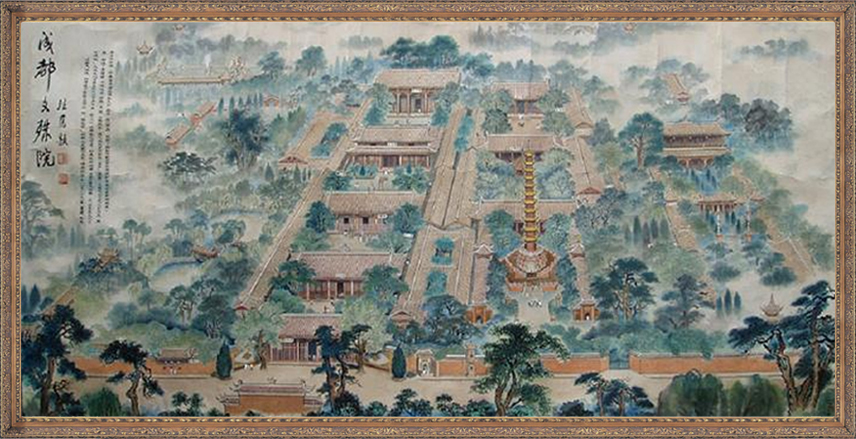SMS verification
>New phones will be automatically registered after verification
I have read then《xxx》user agreement
>New phones will be automatically registered after verification
I have read then《xxx》user agreement
soajfaposdjfoipjwiojfoijs哦i撒娇的富婆脚手架奥i圣诞节覅收到i哦阿斯顿就覅破击破发髻喷完后归热火给iungi如同ij
Wenshu Monastery
Wenshu
Monastery is one of China’s key sinophone Buddhist temples
recognized by the State Council. It is rated as the first of the Four
Zen Monasteries along the Yangtze River, as well as a key cultural
relic acknowledged by Sichuan Province. It is located in the downtown
of Chengdu city, Sichuan Province. It is not only an attraction
combining Buddhist relics, beautiful gardens, ancient architecture
for the layfolk, but also a sacred place for pilgrimage, religious
studies and practice.
The monastery was first built during the Daye period of Sui Dynasty (605-617) with its original name of Xin Xiang Monastery, and went through the rise and fall in the dynasties of Tang, Five Dynasties, Song, Yuan and Ming, but unfortunately a complete ravage in wars at the end of Ming Dynasty. In the 36th year of the Kangxi reign of Qing Dynasty (1697), the monastery was rebuilt by a Zen master named Cidu Haiyue. During the construction, a splendid beam of light was observed over the monastery. People traced the light to the retreat of Master Cidu Haiyue and believed he was the incarnation of Manjusri Bodhisattva. That’s how the Xin Xiang Monastery was renamed as Wenshu Monastery. In the 40th year of Kangxi Period of Qing Dynasty (1701), Emperor Kangxi granted the Wenshu Monastery a plaque “Kong Lin”, meaning the temple of void, so Wenshu Monastery is also known as the “Kong Lin Hall”.
Wenshu Monastery covers more than 60,000 square meters. The architecture, made of wooden with the six main halls in turn facing the gate along the central axis, looks lofty and magnificent. The enchased windows of various types and exquisite craftsmanship find no equals in any other domestic monasteries. Two hundred statues of Buddhas and Bodhisattvas molded with copper, iron, gauze and clay, or carved with wood and stone are impressive in various postures with consummate craftsmanship. Despite of wars and turmoil, these statues have been kept intact, actually a very rare case compared with the devastation suffered by the other domestic Buddhist monasteries. Quantities of rare cultural relics, scriptures, calligraphic works and paintings are garnered here, among which, the most famous things are the skull relic of Master Xuan Zhang, Avatamsaka Sutra written with tongue blood, Avalokitesvara embroidered with human hair, palm-leaf scriptures and works by great calligraphers and painters such as Emperor Kangxi, Prince Yunli, Liu Yong, Zhang Daqian, Xie Wuliang, Feng Zikai, Zhao Puchu and Qi Gong.
Entering the millennium Wenshu Monastery, visitors will not only be impressed by its profound historical and cultural legacy, but also touched by its thriving and solemn Dharma.
The previous name of the Wenshu Monastery is Xinxiang, which was founded in the Daye period of Sui Dynasty (605-617). It has a history of nearly 1400 years. In the Song Dynasty, a Zen Master Zongxian Zhengjue was stayed here to spread Dharma. In the 17th year of Chongzhen period of the Ming Dynasty (1644), it was destroyed by war.
Since the Third Plenary Session of the Eleventh Central Committee of CPC, the first abbot initiated a series of expansion and improvement projects which were very helpful for promoting communication and exchange and the spreading of Dharma.
With the present abbot Master Zongxing’s presiding, Wenshu Monastery sets about to performing maintenance and innovation works. On the other hand, to realize the idea of "Humanistic Buddhism", the monastery establishes two goals to that end: Buddhism education and propagation of Dharma. Kong Lin Buddhist Academy has been reopened and Kong Lin Buddhist Library set up, together with Kong Lin Classroom, which has invited many renowned monks to give lectures, and finally the magazine of Kong Lin Buddhist are published and the Buddhist website of Kong Lin Life launched, all these are helpful for the popularization and promotion of Buddhism.
